E123 Scurtu Elena Alina: Business Communication and Information Report
VerifiedAdded on 2020/10/04
|17
|2760
|309
Report
AI Summary
This report, submitted by a student, delves into the core principles of business communication and information management. It begins by examining the significance of negotiation in a business environment, exploring various approaches like hard, soft, distributed, principled, and integrative negotiation, alongside the identification of key negotiation tactics. The report then shifts its focus to presentations, detailing different types, resource utilization, presentation methods, best practices in delivery, and feedback collection. Furthermore, it analyzes bespoke documents, outlining their characteristics, creation factors, legal requirements, and techniques for gaining approval. Finally, the report covers information system development, analyzing typical stages, benefits, limitations, and legal, security, and confidentiality requirements, concluding with methods for monitoring system effectiveness. The report provides a comprehensive overview of crucial aspects of business communication and information management.
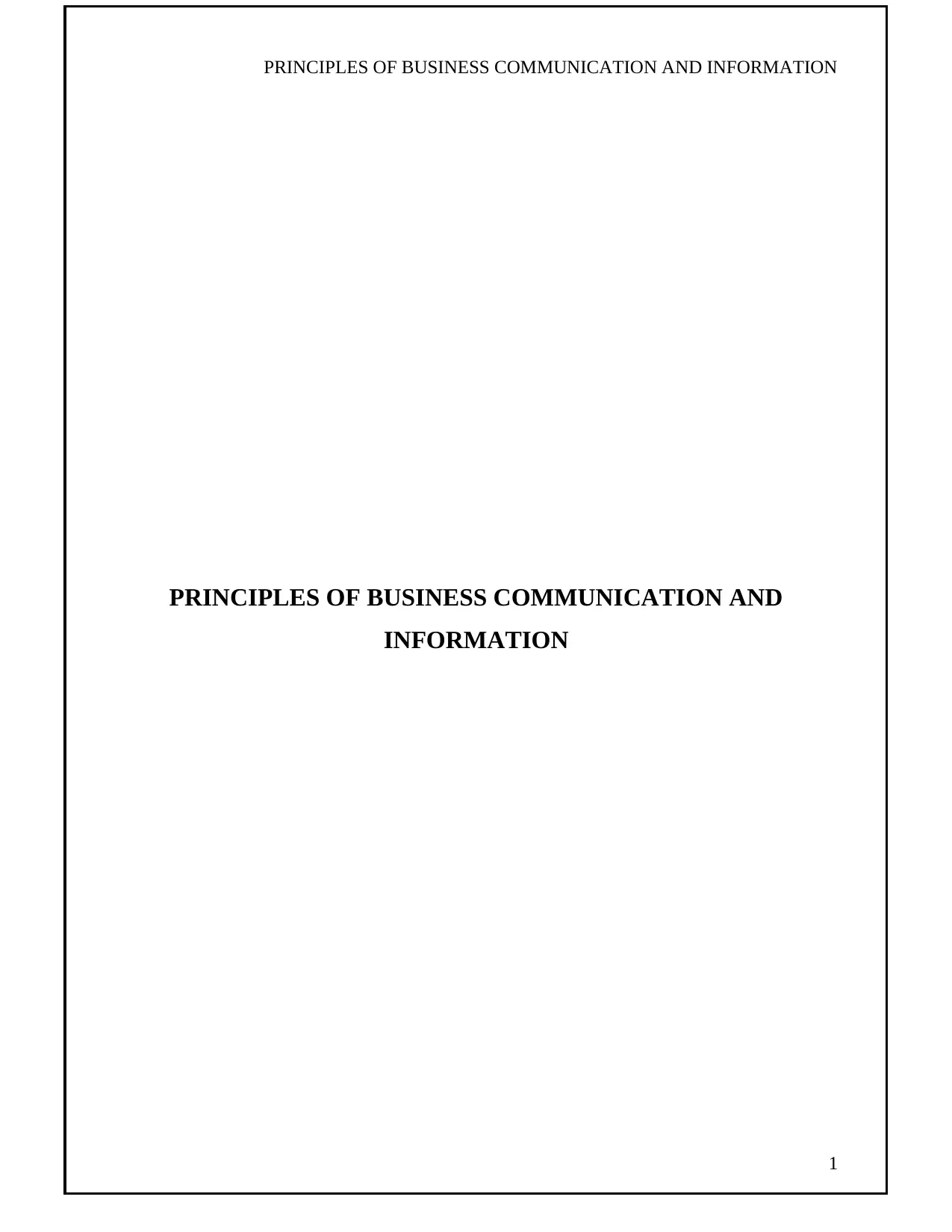
PRINCIPLES OF BUSINESS COMMUNICATION AND INFORMATION
PRINCIPLES OF BUSINESS COMMUNICATION AND
INFORMATION
1
PRINCIPLES OF BUSINESS COMMUNICATION AND
INFORMATION
1
Paraphrase This Document
Need a fresh take? Get an instant paraphrase of this document with our AI Paraphraser
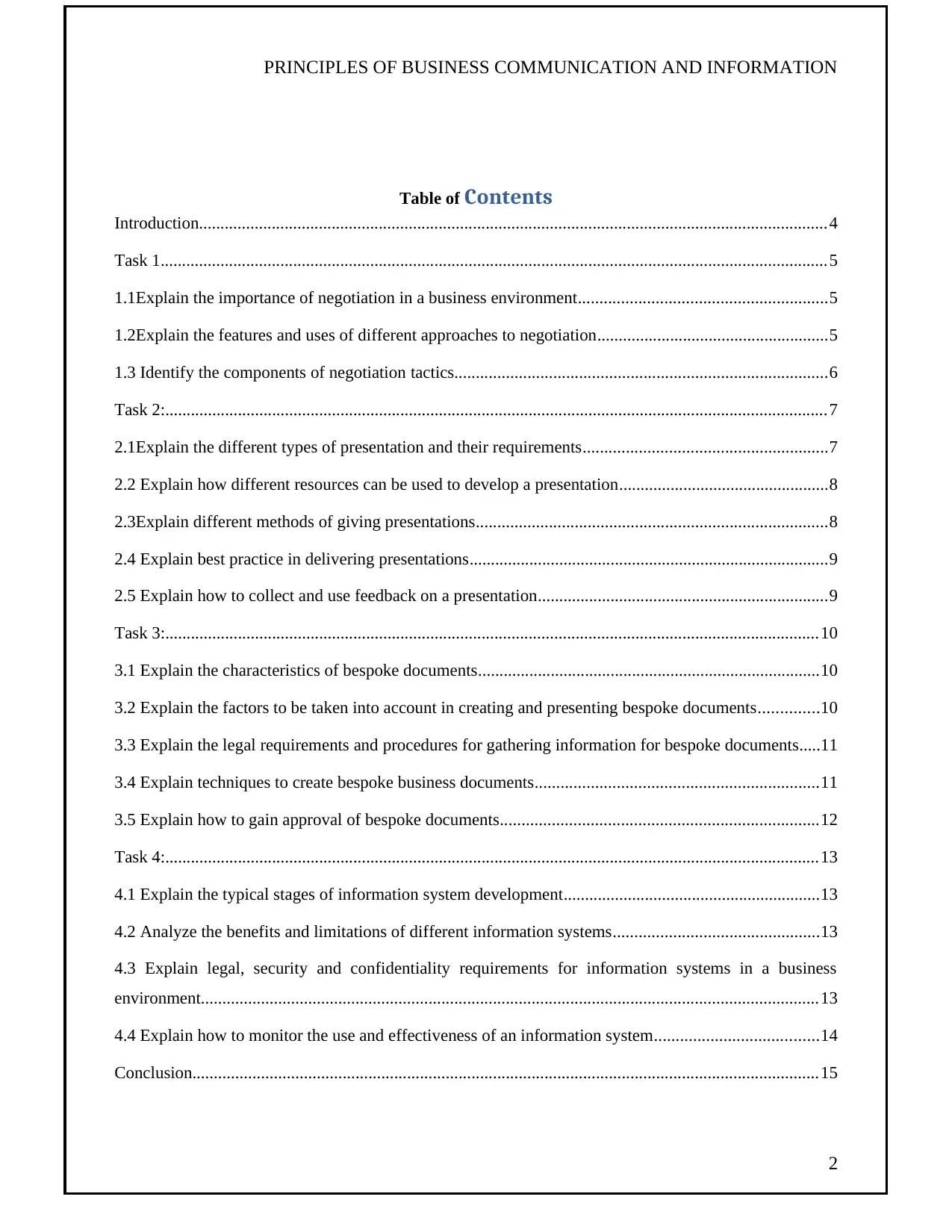
PRINCIPLES OF BUSINESS COMMUNICATION AND INFORMATION
Table of Contents
Introduction...................................................................................................................................................4
Task 1............................................................................................................................................................5
1.1Explain the importance of negotiation in a business environment..........................................................5
1.2Explain the features and uses of different approaches to negotiation......................................................5
1.3 Identify the components of negotiation tactics.......................................................................................6
Task 2:...........................................................................................................................................................7
2.1Explain the different types of presentation and their requirements.........................................................7
2.2 Explain how different resources can be used to develop a presentation.................................................8
2.3Explain different methods of giving presentations..................................................................................8
2.4 Explain best practice in delivering presentations....................................................................................9
2.5 Explain how to collect and use feedback on a presentation....................................................................9
Task 3:.........................................................................................................................................................10
3.1 Explain the characteristics of bespoke documents................................................................................10
3.2 Explain the factors to be taken into account in creating and presenting bespoke documents..............10
3.3 Explain the legal requirements and procedures for gathering information for bespoke documents.....11
3.4 Explain techniques to create bespoke business documents..................................................................11
3.5 Explain how to gain approval of bespoke documents..........................................................................12
Task 4:.........................................................................................................................................................13
4.1 Explain the typical stages of information system development............................................................13
4.2 Analyze the benefits and limitations of different information systems................................................13
4.3 Explain legal, security and confidentiality requirements for information systems in a business
environment................................................................................................................................................13
4.4 Explain how to monitor the use and effectiveness of an information system......................................14
Conclusion..................................................................................................................................................15
2
Table of Contents
Introduction...................................................................................................................................................4
Task 1............................................................................................................................................................5
1.1Explain the importance of negotiation in a business environment..........................................................5
1.2Explain the features and uses of different approaches to negotiation......................................................5
1.3 Identify the components of negotiation tactics.......................................................................................6
Task 2:...........................................................................................................................................................7
2.1Explain the different types of presentation and their requirements.........................................................7
2.2 Explain how different resources can be used to develop a presentation.................................................8
2.3Explain different methods of giving presentations..................................................................................8
2.4 Explain best practice in delivering presentations....................................................................................9
2.5 Explain how to collect and use feedback on a presentation....................................................................9
Task 3:.........................................................................................................................................................10
3.1 Explain the characteristics of bespoke documents................................................................................10
3.2 Explain the factors to be taken into account in creating and presenting bespoke documents..............10
3.3 Explain the legal requirements and procedures for gathering information for bespoke documents.....11
3.4 Explain techniques to create bespoke business documents..................................................................11
3.5 Explain how to gain approval of bespoke documents..........................................................................12
Task 4:.........................................................................................................................................................13
4.1 Explain the typical stages of information system development............................................................13
4.2 Analyze the benefits and limitations of different information systems................................................13
4.3 Explain legal, security and confidentiality requirements for information systems in a business
environment................................................................................................................................................13
4.4 Explain how to monitor the use and effectiveness of an information system......................................14
Conclusion..................................................................................................................................................15
2
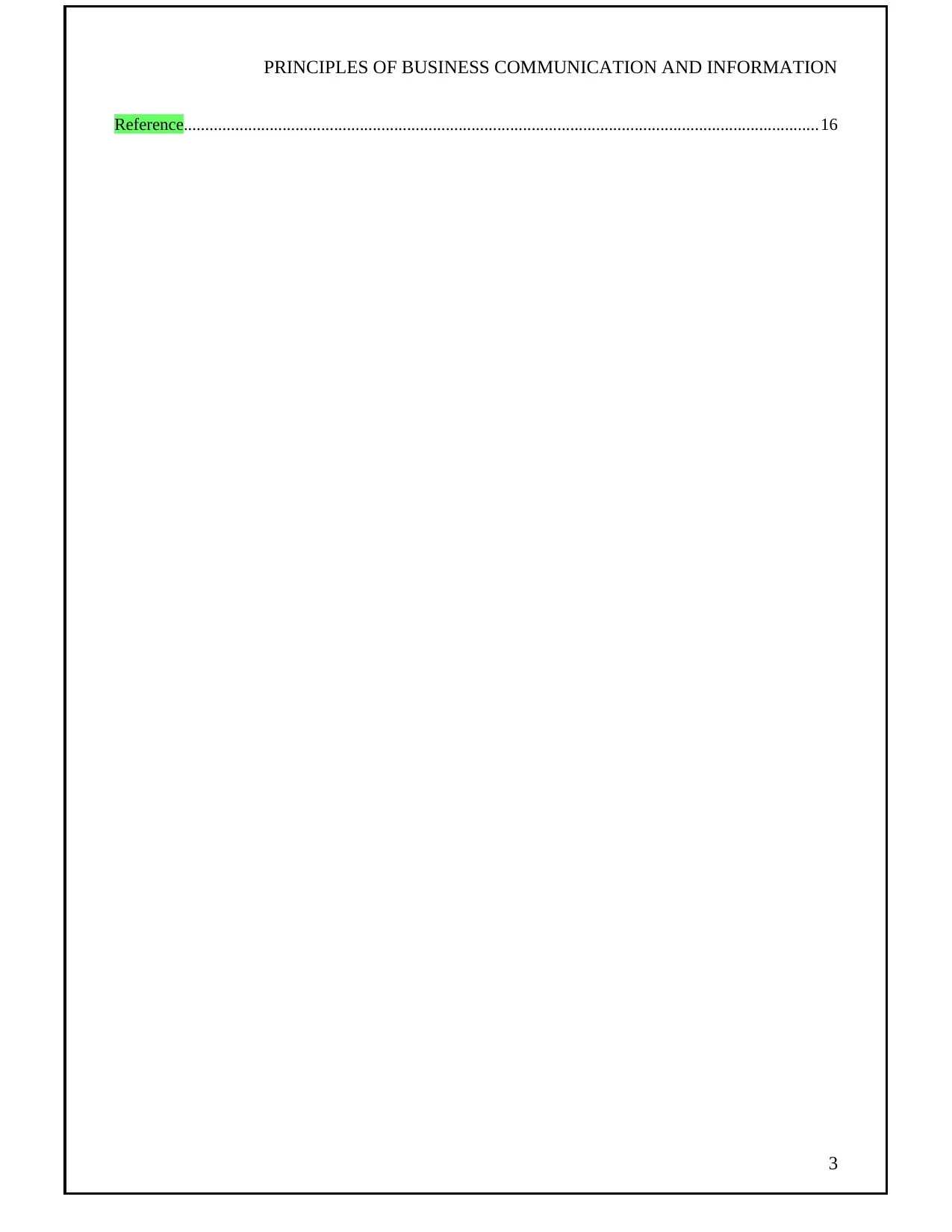
PRINCIPLES OF BUSINESS COMMUNICATION AND INFORMATION
Reference....................................................................................................................................................16
3
Reference....................................................................................................................................................16
3
⊘ This is a preview!⊘
Do you want full access?
Subscribe today to unlock all pages.

Trusted by 1+ million students worldwide
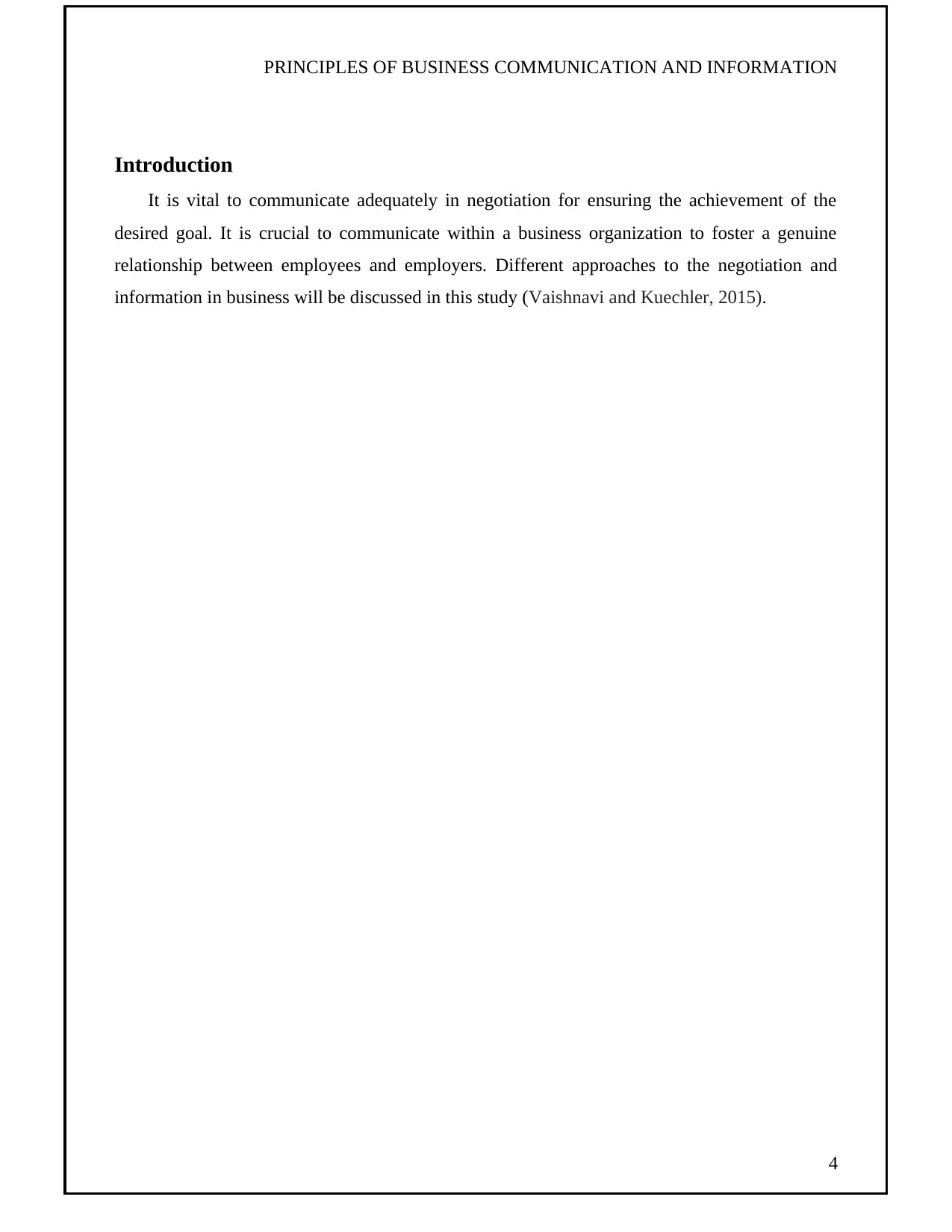
PRINCIPLES OF BUSINESS COMMUNICATION AND INFORMATION
Introduction
It is vital to communicate adequately in negotiation for ensuring the achievement of the
desired goal. It is crucial to communicate within a business organization to foster a genuine
relationship between employees and employers. Different approaches to the negotiation and
information in business will be discussed in this study (Vaishnavi and Kuechler, 2015).
4
Introduction
It is vital to communicate adequately in negotiation for ensuring the achievement of the
desired goal. It is crucial to communicate within a business organization to foster a genuine
relationship between employees and employers. Different approaches to the negotiation and
information in business will be discussed in this study (Vaishnavi and Kuechler, 2015).
4
Paraphrase This Document
Need a fresh take? Get an instant paraphrase of this document with our AI Paraphraser

PRINCIPLES OF BUSINESS COMMUNICATION AND INFORMATION
Task 1
1.1Explain the importance of negotiation in a business environment
Negotiation is the process where different parties can able to share their requirements and
issues with their desired goal to find out a sustainable solution. The primary purpose of
negotiation is to deal with an agreement which will be beneficial for both parties. As stated by
Vom et al. (2014), it gives a positive impact on business by building up a good relation,
providing a long-term solution which also helps to reduce future conflicts. Negotiation process
depends upon the give and takes policy. Negotiation is the beginning of a commercial
transaction, fixing salaries for employees and purchasing equipment. Preferably in a successful
negotiation, a little adjustment of an organization means a lot to the other party (El-Masri et al.
2015).
The importance of negotiation in business environment which are as follows
It helps you to build better relationship
It helps to avoid conflicts and future problems
It maintain daily interaction day to day and simple transaction such as service delivery,
sales and other contract
1.2Explain the features and uses of different approaches to negotiation
Approaches to negotiation involve-
Hard negotiation: Hard negotiation practice completely betraying the understanding about the
gains which can be achieved in many business negotiations. When the negotiators utilize hard
negotiation tactics, they bring that they take negotiation as a win-lose enterprise.
Soft Negotiation: It is the approach which focused on preserving the relationship with the
parties for future benefits. As stated by Hills (2016), this approach believes in the mutual win-
win outcome of the disputes.
5
Task 1
1.1Explain the importance of negotiation in a business environment
Negotiation is the process where different parties can able to share their requirements and
issues with their desired goal to find out a sustainable solution. The primary purpose of
negotiation is to deal with an agreement which will be beneficial for both parties. As stated by
Vom et al. (2014), it gives a positive impact on business by building up a good relation,
providing a long-term solution which also helps to reduce future conflicts. Negotiation process
depends upon the give and takes policy. Negotiation is the beginning of a commercial
transaction, fixing salaries for employees and purchasing equipment. Preferably in a successful
negotiation, a little adjustment of an organization means a lot to the other party (El-Masri et al.
2015).
The importance of negotiation in business environment which are as follows
It helps you to build better relationship
It helps to avoid conflicts and future problems
It maintain daily interaction day to day and simple transaction such as service delivery,
sales and other contract
1.2Explain the features and uses of different approaches to negotiation
Approaches to negotiation involve-
Hard negotiation: Hard negotiation practice completely betraying the understanding about the
gains which can be achieved in many business negotiations. When the negotiators utilize hard
negotiation tactics, they bring that they take negotiation as a win-lose enterprise.
Soft Negotiation: It is the approach which focused on preserving the relationship with the
parties for future benefits. As stated by Hills (2016), this approach believes in the mutual win-
win outcome of the disputes.
5
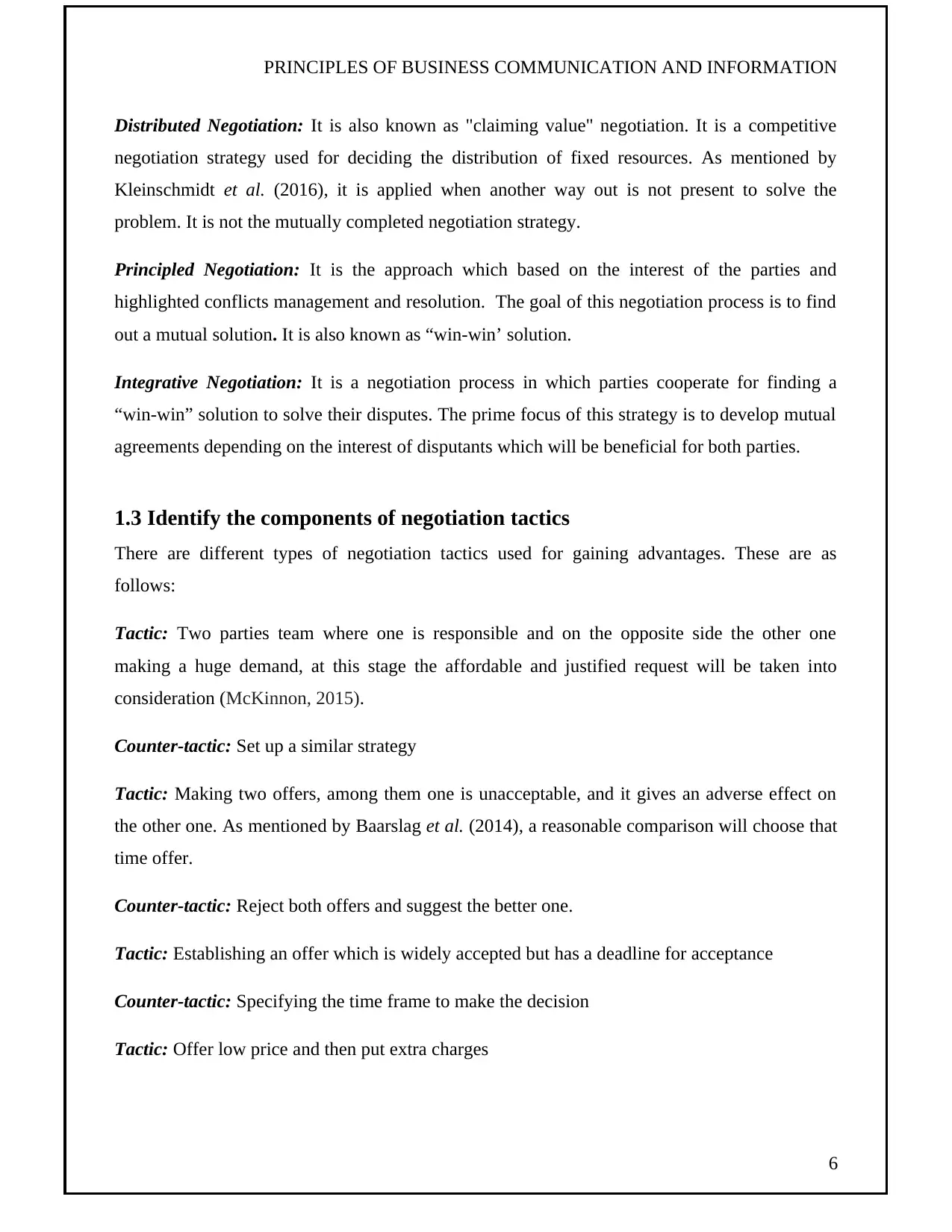
PRINCIPLES OF BUSINESS COMMUNICATION AND INFORMATION
Distributed Negotiation: It is also known as "claiming value" negotiation. It is a competitive
negotiation strategy used for deciding the distribution of fixed resources. As mentioned by
Kleinschmidt et al. (2016), it is applied when another way out is not present to solve the
problem. It is not the mutually completed negotiation strategy.
Principled Negotiation: It is the approach which based on the interest of the parties and
highlighted conflicts management and resolution. The goal of this negotiation process is to find
out a mutual solution. It is also known as “win-win’ solution.
Integrative Negotiation: It is a negotiation process in which parties cooperate for finding a
“win-win” solution to solve their disputes. The prime focus of this strategy is to develop mutual
agreements depending on the interest of disputants which will be beneficial for both parties.
1.3 Identify the components of negotiation tactics
There are different types of negotiation tactics used for gaining advantages. These are as
follows:
Tactic: Two parties team where one is responsible and on the opposite side the other one
making a huge demand, at this stage the affordable and justified request will be taken into
consideration (McKinnon, 2015).
Counter-tactic: Set up a similar strategy
Tactic: Making two offers, among them one is unacceptable, and it gives an adverse effect on
the other one. As mentioned by Baarslag et al. (2014), a reasonable comparison will choose that
time offer.
Counter-tactic: Reject both offers and suggest the better one.
Tactic: Establishing an offer which is widely accepted but has a deadline for acceptance
Counter-tactic: Specifying the time frame to make the decision
Tactic: Offer low price and then put extra charges
6
Distributed Negotiation: It is also known as "claiming value" negotiation. It is a competitive
negotiation strategy used for deciding the distribution of fixed resources. As mentioned by
Kleinschmidt et al. (2016), it is applied when another way out is not present to solve the
problem. It is not the mutually completed negotiation strategy.
Principled Negotiation: It is the approach which based on the interest of the parties and
highlighted conflicts management and resolution. The goal of this negotiation process is to find
out a mutual solution. It is also known as “win-win’ solution.
Integrative Negotiation: It is a negotiation process in which parties cooperate for finding a
“win-win” solution to solve their disputes. The prime focus of this strategy is to develop mutual
agreements depending on the interest of disputants which will be beneficial for both parties.
1.3 Identify the components of negotiation tactics
There are different types of negotiation tactics used for gaining advantages. These are as
follows:
Tactic: Two parties team where one is responsible and on the opposite side the other one
making a huge demand, at this stage the affordable and justified request will be taken into
consideration (McKinnon, 2015).
Counter-tactic: Set up a similar strategy
Tactic: Making two offers, among them one is unacceptable, and it gives an adverse effect on
the other one. As mentioned by Baarslag et al. (2014), a reasonable comparison will choose that
time offer.
Counter-tactic: Reject both offers and suggest the better one.
Tactic: Establishing an offer which is widely accepted but has a deadline for acceptance
Counter-tactic: Specifying the time frame to make the decision
Tactic: Offer low price and then put extra charges
6
⊘ This is a preview!⊘
Do you want full access?
Subscribe today to unlock all pages.

Trusted by 1+ million students worldwide

PRINCIPLES OF BUSINESS COMMUNICATION AND INFORMATION
Counter-tactic: Making proper specification of details so that there is no place for additional
costs.
Collaborative tactics: The collaborative tactics state that the tactics of humanity are more
important than individual tactics of people.
Neutral tactics: These are the tactics that offer a neutral solution to the issues.
Task 2:
2.1Explain the different types of presentation and their requirements
Different types of presentation are there, namely-
Formal: Presenting the views adequately to every individual to a given time frame.
Informal: Only helps when the speakers knew that the audience is interested and good.
Demonstrations: This kind of presentation illustrates the work process which helps
others to understand the process and work accordingly.
Informational: It consists of numerous information related to their study.
Persuasion: It is a kind of presentation which helps to change the mindset of others in a
particular issue.
Training: This kind of presentation helps to engage the audience and increase their
interest in the topic.
7
Counter-tactic: Making proper specification of details so that there is no place for additional
costs.
Collaborative tactics: The collaborative tactics state that the tactics of humanity are more
important than individual tactics of people.
Neutral tactics: These are the tactics that offer a neutral solution to the issues.
Task 2:
2.1Explain the different types of presentation and their requirements
Different types of presentation are there, namely-
Formal: Presenting the views adequately to every individual to a given time frame.
Informal: Only helps when the speakers knew that the audience is interested and good.
Demonstrations: This kind of presentation illustrates the work process which helps
others to understand the process and work accordingly.
Informational: It consists of numerous information related to their study.
Persuasion: It is a kind of presentation which helps to change the mindset of others in a
particular issue.
Training: This kind of presentation helps to engage the audience and increase their
interest in the topic.
7
Paraphrase This Document
Need a fresh take? Get an instant paraphrase of this document with our AI Paraphraser
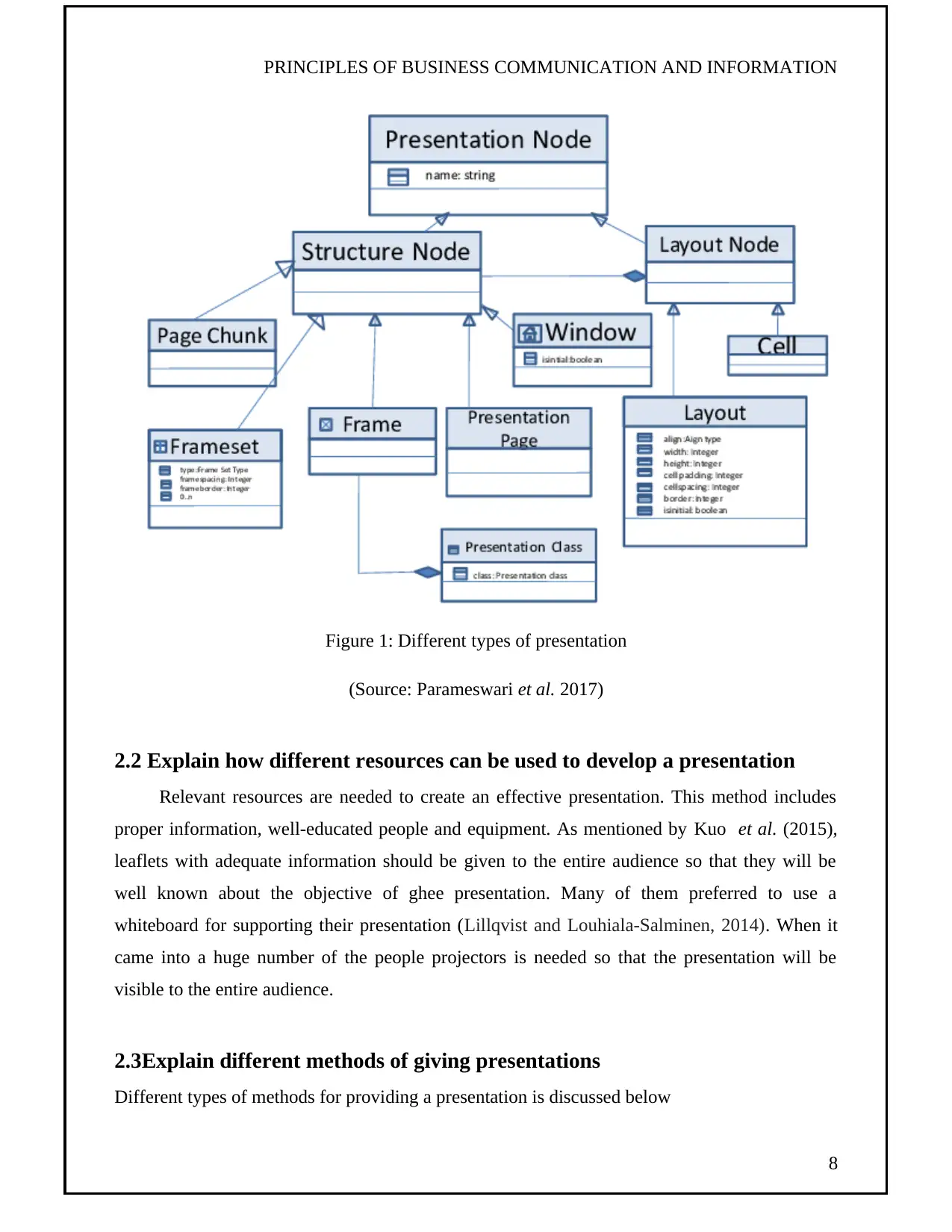
PRINCIPLES OF BUSINESS COMMUNICATION AND INFORMATION
Figure 1: Different types of presentation
(Source: Parameswari et al. 2017)
2.2 Explain how different resources can be used to develop a presentation
Relevant resources are needed to create an effective presentation. This method includes
proper information, well-educated people and equipment. As mentioned by Kuo et al. (2015),
leaflets with adequate information should be given to the entire audience so that they will be
well known about the objective of ghee presentation. Many of them preferred to use a
whiteboard for supporting their presentation (Lillqvist and Louhiala-Salminen, 2014). When it
came into a huge number of the people projectors is needed so that the presentation will be
visible to the entire audience.
2.3Explain different methods of giving presentations
Different types of methods for providing a presentation is discussed below
8
Figure 1: Different types of presentation
(Source: Parameswari et al. 2017)
2.2 Explain how different resources can be used to develop a presentation
Relevant resources are needed to create an effective presentation. This method includes
proper information, well-educated people and equipment. As mentioned by Kuo et al. (2015),
leaflets with adequate information should be given to the entire audience so that they will be
well known about the objective of ghee presentation. Many of them preferred to use a
whiteboard for supporting their presentation (Lillqvist and Louhiala-Salminen, 2014). When it
came into a huge number of the people projectors is needed so that the presentation will be
visible to the entire audience.
2.3Explain different methods of giving presentations
Different types of methods for providing a presentation is discussed below
8
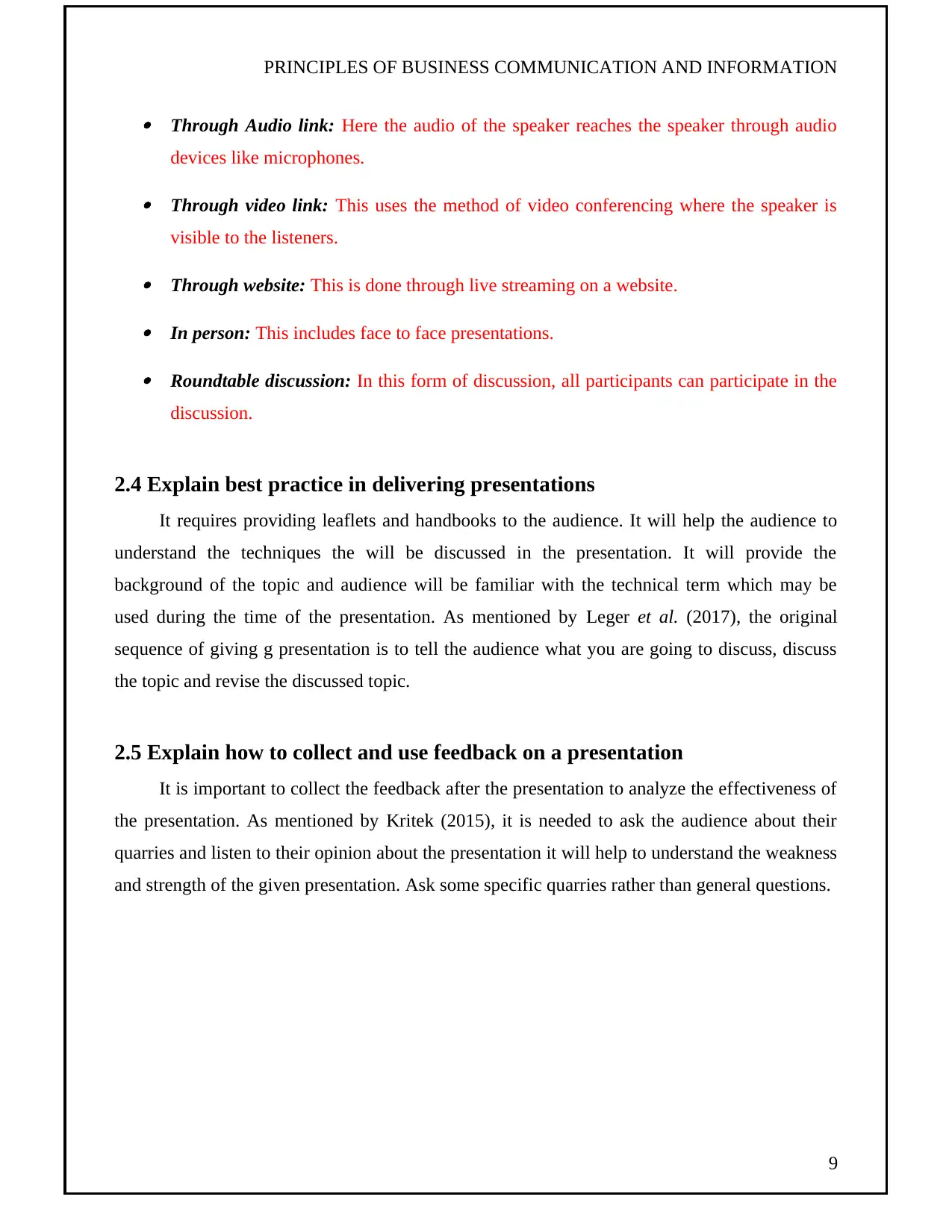
PRINCIPLES OF BUSINESS COMMUNICATION AND INFORMATION
Through Audio link: Here the audio of the speaker reaches the speaker through audio
devices like microphones.
Through video link: This uses the method of video conferencing where the speaker is
visible to the listeners.
Through website: This is done through live streaming on a website.
In person: This includes face to face presentations.
Roundtable discussion: In this form of discussion, all participants can participate in the
discussion.
2.4 Explain best practice in delivering presentations
It requires providing leaflets and handbooks to the audience. It will help the audience to
understand the techniques the will be discussed in the presentation. It will provide the
background of the topic and audience will be familiar with the technical term which may be
used during the time of the presentation. As mentioned by Leger et al. (2017), the original
sequence of giving g presentation is to tell the audience what you are going to discuss, discuss
the topic and revise the discussed topic.
2.5 Explain how to collect and use feedback on a presentation
It is important to collect the feedback after the presentation to analyze the effectiveness of
the presentation. As mentioned by Kritek (2015), it is needed to ask the audience about their
quarries and listen to their opinion about the presentation it will help to understand the weakness
and strength of the given presentation. Ask some specific quarries rather than general questions.
9
Through Audio link: Here the audio of the speaker reaches the speaker through audio
devices like microphones.
Through video link: This uses the method of video conferencing where the speaker is
visible to the listeners.
Through website: This is done through live streaming on a website.
In person: This includes face to face presentations.
Roundtable discussion: In this form of discussion, all participants can participate in the
discussion.
2.4 Explain best practice in delivering presentations
It requires providing leaflets and handbooks to the audience. It will help the audience to
understand the techniques the will be discussed in the presentation. It will provide the
background of the topic and audience will be familiar with the technical term which may be
used during the time of the presentation. As mentioned by Leger et al. (2017), the original
sequence of giving g presentation is to tell the audience what you are going to discuss, discuss
the topic and revise the discussed topic.
2.5 Explain how to collect and use feedback on a presentation
It is important to collect the feedback after the presentation to analyze the effectiveness of
the presentation. As mentioned by Kritek (2015), it is needed to ask the audience about their
quarries and listen to their opinion about the presentation it will help to understand the weakness
and strength of the given presentation. Ask some specific quarries rather than general questions.
9
⊘ This is a preview!⊘
Do you want full access?
Subscribe today to unlock all pages.

Trusted by 1+ million students worldwide
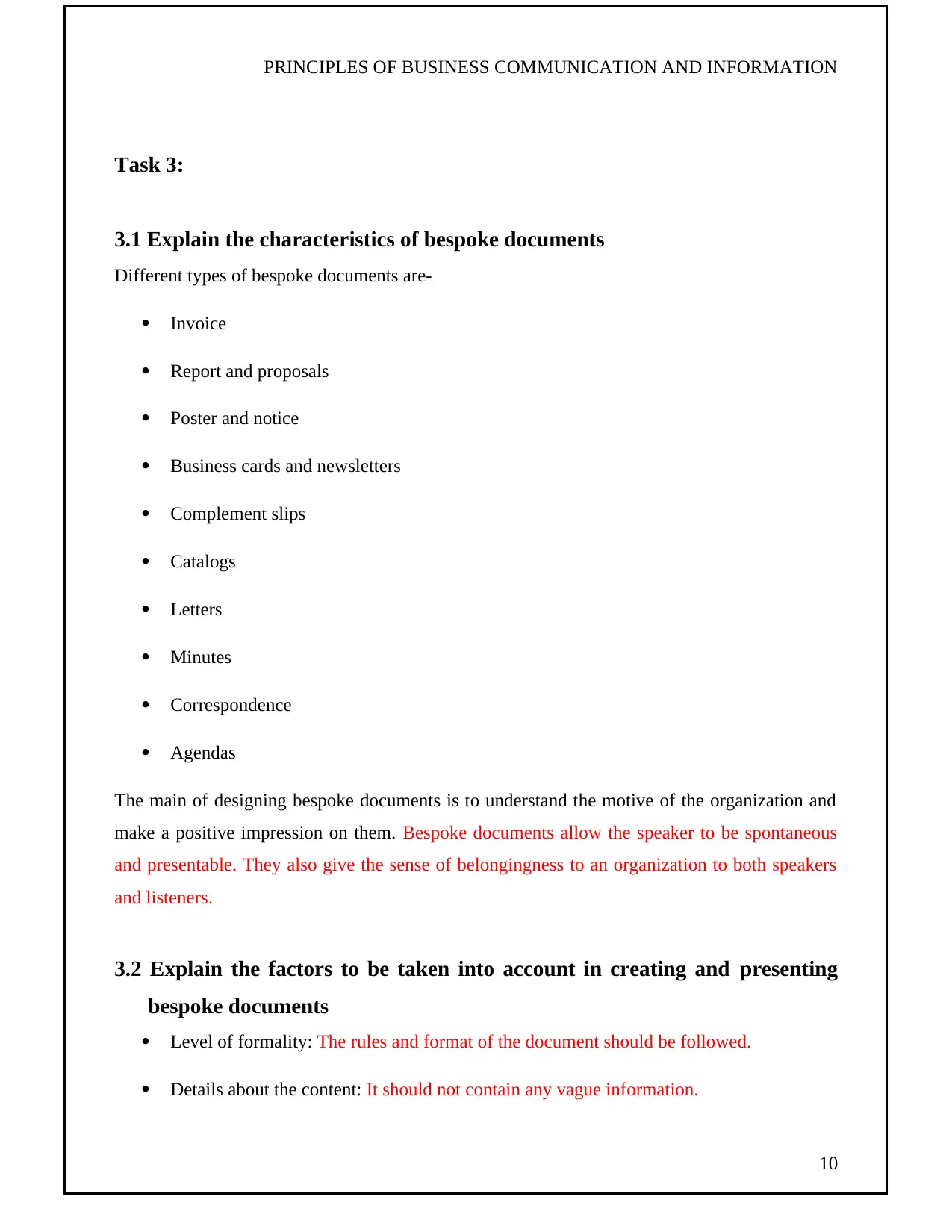
PRINCIPLES OF BUSINESS COMMUNICATION AND INFORMATION
Task 3:
3.1 Explain the characteristics of bespoke documents
Different types of bespoke documents are-
Invoice
Report and proposals
Poster and notice
Business cards and newsletters
Complement slips
Catalogs
Letters
Minutes
Correspondence
Agendas
The main of designing bespoke documents is to understand the motive of the organization and
make a positive impression on them. Bespoke documents allow the speaker to be spontaneous
and presentable. They also give the sense of belongingness to an organization to both speakers
and listeners.
3.2 Explain the factors to be taken into account in creating and presenting
bespoke documents
Level of formality: The rules and format of the document should be followed.
Details about the content: It should not contain any vague information.
10
Task 3:
3.1 Explain the characteristics of bespoke documents
Different types of bespoke documents are-
Invoice
Report and proposals
Poster and notice
Business cards and newsletters
Complement slips
Catalogs
Letters
Minutes
Correspondence
Agendas
The main of designing bespoke documents is to understand the motive of the organization and
make a positive impression on them. Bespoke documents allow the speaker to be spontaneous
and presentable. They also give the sense of belongingness to an organization to both speakers
and listeners.
3.2 Explain the factors to be taken into account in creating and presenting
bespoke documents
Level of formality: The rules and format of the document should be followed.
Details about the content: It should not contain any vague information.
10
Paraphrase This Document
Need a fresh take? Get an instant paraphrase of this document with our AI Paraphraser

PRINCIPLES OF BUSINESS COMMUNICATION AND INFORMATION
Providing it scope: It should present its purpose clearly.
Discussing the purpose: There should be no filler statements.
Limitations- budget, confidentiality: It should respect the privacy of company and
speakers.
Purpose and application: It should not discuss any external matter.
3.3 Explain the legal requirements and procedures for gathering information
for bespoke documents
These documents are considered under the Data Protection Act (Laudon and Laudon 2016).
These conclude-
Accurate updates of the information
Do not send in the other counties without necessary protection
Don’t keep the documents longer than the time frame
Using process in a limited purpose
Using lawful and fair process
Providing fair and relevant data regarding the topic
3.4 Explain techniques to create bespoke business documents
Using appropriate soft to create layouts and designs
Mutual understanding with the relevant people for promoting documents
Checking the accuracy of data, information, and graphs
Revising the content of the document
Using feedback
11
Providing it scope: It should present its purpose clearly.
Discussing the purpose: There should be no filler statements.
Limitations- budget, confidentiality: It should respect the privacy of company and
speakers.
Purpose and application: It should not discuss any external matter.
3.3 Explain the legal requirements and procedures for gathering information
for bespoke documents
These documents are considered under the Data Protection Act (Laudon and Laudon 2016).
These conclude-
Accurate updates of the information
Do not send in the other counties without necessary protection
Don’t keep the documents longer than the time frame
Using process in a limited purpose
Using lawful and fair process
Providing fair and relevant data regarding the topic
3.4 Explain techniques to create bespoke business documents
Using appropriate soft to create layouts and designs
Mutual understanding with the relevant people for promoting documents
Checking the accuracy of data, information, and graphs
Revising the content of the document
Using feedback
11
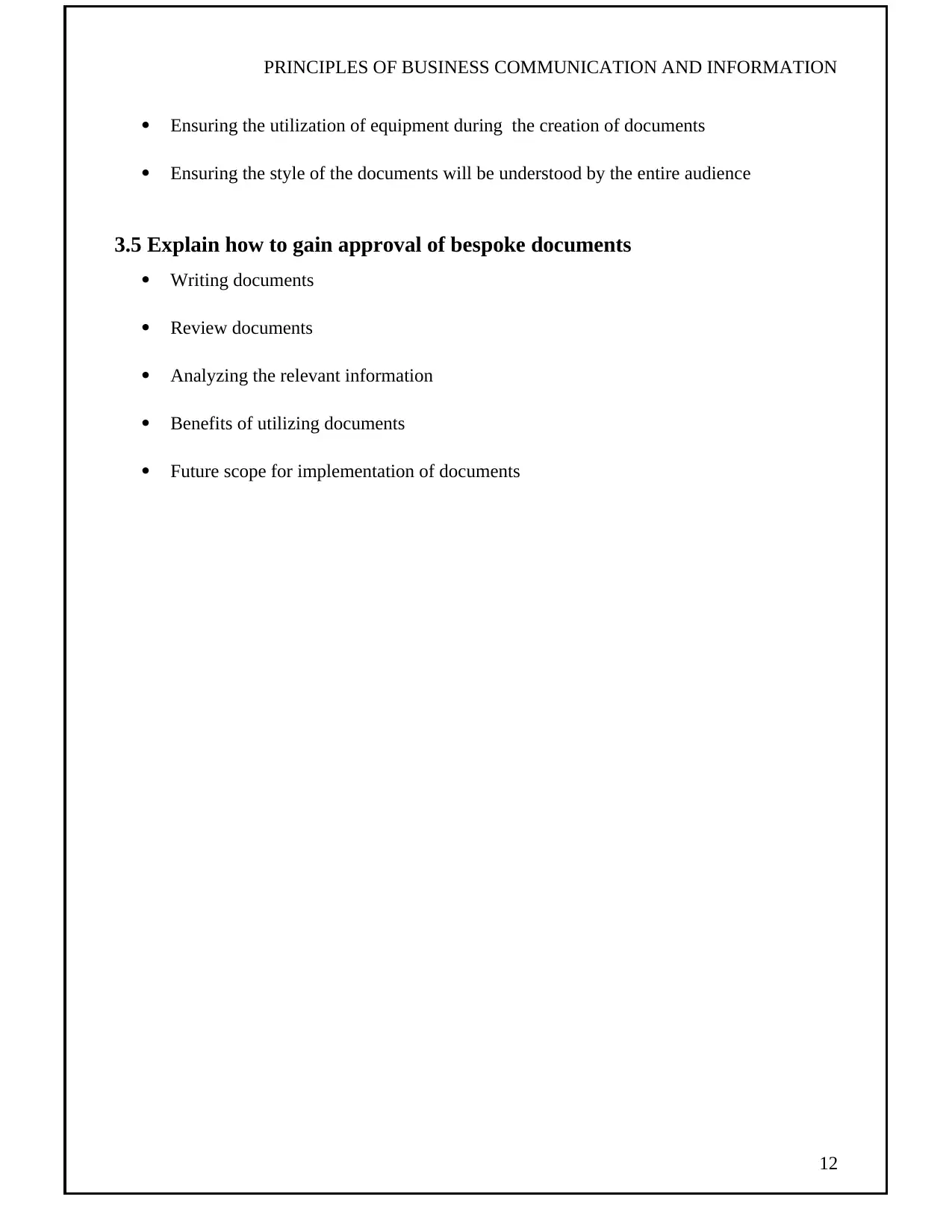
PRINCIPLES OF BUSINESS COMMUNICATION AND INFORMATION
Ensuring the utilization of equipment during the creation of documents
Ensuring the style of the documents will be understood by the entire audience
3.5 Explain how to gain approval of bespoke documents
Writing documents
Review documents
Analyzing the relevant information
Benefits of utilizing documents
Future scope for implementation of documents
12
Ensuring the utilization of equipment during the creation of documents
Ensuring the style of the documents will be understood by the entire audience
3.5 Explain how to gain approval of bespoke documents
Writing documents
Review documents
Analyzing the relevant information
Benefits of utilizing documents
Future scope for implementation of documents
12
⊘ This is a preview!⊘
Do you want full access?
Subscribe today to unlock all pages.

Trusted by 1+ million students worldwide
1 out of 17
Related Documents
Your All-in-One AI-Powered Toolkit for Academic Success.
+13062052269
info@desklib.com
Available 24*7 on WhatsApp / Email
![[object Object]](/_next/static/media/star-bottom.7253800d.svg)
Unlock your academic potential
Copyright © 2020–2025 A2Z Services. All Rights Reserved. Developed and managed by ZUCOL.





